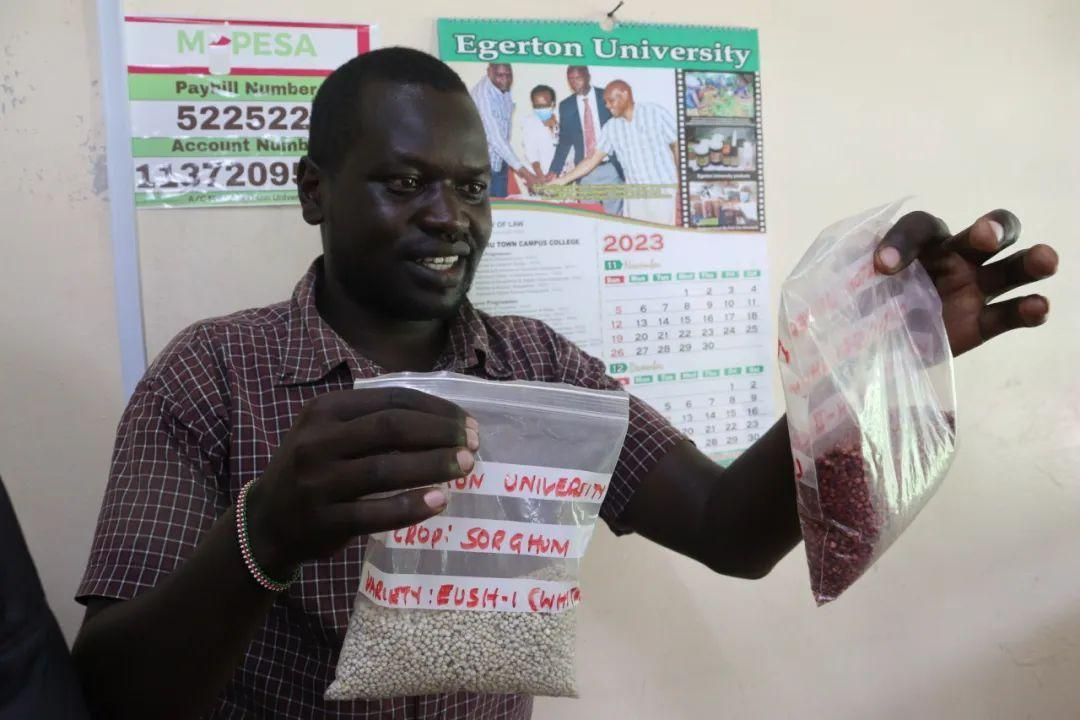
The worker is showing the newly developed crop varieties. [Photo/Tsinghua University]
A turquoise, postmodern guard post reminiscent of an airport control tower looks out unto the C57 road. On the unpaved strip of land opposite the guard post, purveyors of fruits, legumes, and sundries tend to makeshift stalls under the shade of tattered beach umbrellas. The post guards the entrance to Egerton University's main campus at Njoro, one of Kenya's leading universities, known for its prowess in agriculture and, since 1994, its extensive collaboration with Nanjing Agricultural University (NAU) in catalysing rural revitalisation.
I had the pleasure of visiting this pastoral but vibrant campus on the morning of the 26th of January, along with eight other members of my study tour. Our first stop was the China-Kenya Belt and Road Joint Laboratory on Crop Molecular Biology, a product of collaboration with NAU formally recognised as one of the first Belt and Road Joint Laboratories in 2019. The lab serves as an R&D hub for pest-, drought-, and disease-tolerant crops, leveraging Chinese expertise and state-of-the-art equipment subsidised by the Chinese government to facilitate local scientists' work on crop selection and breeding. We were enthusiastically taken around the lab by a researcher working on the genomic characterisation of similar-looking crops collected from different parts of the country to rectify mislabelling by farmers, if present.
Our next stop was the Agro-Science Park Innovation Centre's experimental farm, where new crop varieties are tested on Egerton's sprawling campus. We were shown newly developed crop varieties, including grains, beans, tomatoes and cassava, and a sample of the distribution contracts the Centre signs with local smallholders. In these contracts, the Centre sells experimental crop varieties and agrees to purchase the produce at a fixed price, thereby transferring risk to the Centre and increasing farmers' receptiveness to new varieties.
In the afternoon, we headed to the Matangi Tisa Village, crowned Kenya's first Demonstration Village for China-Africa Agricultural Development and Poverty Reduction in 2022 under the auspices of the Belt and Road Initiative. Perhaps our arrival came as a welcome surprise for local smallholder and retired primary schoolteacher Anna Wanjiku ("I'm retired, but not tired!" she later remarked), who was in the midst of a goose-feeding session but quickly escorted us into a husking shed after exchanging some pleasantries. Strewn above white sheets of tarp laid on the floor were high-yield beans of the Chelalang variety, developed by the Joint Laboratory. Resilient against long rainy seasons, droughts, and acidic soil, these attributes became quite significant last year, when erratic changes in rainfall patterns and local farmers anticipating rainfall that never came resulted in crop failure elsewhere, increasing the bean's popularity. After generously gifting us stalks of field corn, Anna bid us farewell, and we thanked her for her time and hospitality.
That we visited these sites that day is no coincidence: together, they form a complete development-testing-distribution pipeline, whereas Anna remains a well-respected authority figure in her village – important if crop varieties and farming techniques are to be distributed by word of mouth. Though we did not see examples of it, cooperation between Egerton and NAU also takes the form of training for farmers and extension workers on improved agronomy, whilst the Joint Laboratory also offers training for regional experts in breeding climate-resilient crops, expediting knowledge and technology transfer.
Distributing improved crop varieties combats hunger, malnutrition and rural poverty by mitigating such challenges as pests, diseases, volatile overhead costs, increasingly erratic rains, and reduced soil fertility. Yet, this progress in rural revitalisation pales in comparison to potential productivity gains from solving Kenya's low irrigation coverage and low rate of agriculture mechanisation (I did not see a single farm vehicle throughout my stay). Anna tells me her mission is to encourage youths to enter agriculture instead of swamping the towns, where she thinks opportunities do not necessarily exist for everyone, but this is a telltale sign that agriculture involves more of Kenya's population in manual agricultural labour than it ought. Compounded with the coconut vendor with a bachelor's in mechanical engineering I met at a beach in Mombasa, this gives the impression that underemployment abounds. Kenya is blessed with a relatively well-educated population compared to its neighbours, and this repository of talent ought not go to waste.
Given enough capital investment and political willpower, the same pipeline of subsidised R&D, small-scale testing, opinion leader-based grassroots distribution involving risk transfer, and comprehensive training could be replicated in related fields – e.g., scalable low-cost farm equipment – piggybacking on the relative success of Sino-African cooperation in agriculture, to better leverage Kenya's human resources for a more productive and climate-resilient economy. A better future beckons, with the promise of equity through rural revitalisation, longevity through nutrition and peace through food security.
原文链接: From peas to peace: Lessons from Njoro - China.org.cn